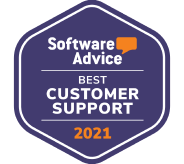Collecting Customer Feedback is an essential part of any business to know how your customers feel about the experience you provide them. Various types of surveys are used to gauge Customer Experience. And when you want to measure Customer Satisfaction and experience in quantitative terms, Opinion Scale Surveys are one of the best options.
Opinion Scales Surveys or rating surveys let you know how your customers rate the experience you provide them. In this article, we will explore more about 1 to 10 Opinion Scale Surveys, their uses, and some smart tips to effectively use the 1 to 10 Opinion Scale surveys. Let’s know what Opinion Scale Surveys are.
What is an Opinion Scale Survey?
Opinion Scale Survey is a common type of survey wherein customers are asked to share their opinion on their experience with a product, service, or any aspect of the business in the form of scores on a rating scale.
An Opinion scale can be both descriptive as well as numeric. In a 1 to 10 Opinion Scale Survey, a numeric scale is provided where rating options lie from 1 to 10, among which the customers can choose a score to rate their experience. Here, ten represents the most positive experience, and one(or zero) illustrates the most negative experience.
One of the most common examples of this survey is a Net Promoter Score Survey. In this survey, customers are asked their likeliness to recommend a business to their friends and known ones on a scale of 0 to 10, where 10 means Most Likely, and 0 means Not at all Likely to recommend.
Let’s explore how and where you can use a 1 to 10 opinion Scale Survey.
How to Use 1 to 10 Opinion Scale Survey?
- To measure Customer Satisfaction
- To measure Customer Loyalty with NPS
- To rate your Products and Services
- To rate your Employees Performance
- To collect feedback at various touchpoints
Let’s know more about these uses of 1 to 10 Opinions Scale Surveys.
1. To measure Customer Satisfaction
Surveys are a great way to collect customer feedback. And when you want to measure the satisfaction level of your customers in quantitative terms, Opinion Scale Surveys are the best choice. With these surveys, you get a clear idea of how satisfied your customers are with your products and services.
2. To measure Customer Loyalty with NPS
Net Promoter Score is the measure of Customer Loyalty towards your business. An NPS survey is sent to the customers asking their likeliness to refer your brand or business for measuring NPS. It is a single or a couple-question survey, and the main question of the survey, which is also called The Ultimate Question is,
“How likely are you to recommend this business to your friends and colleagues?”
It is one of the best examples of the use of the Opinion Scale. However, the opinion scale in this survey lies from 0 to 10, where ten means ‘Most Likely to Recommend’ and 0 means ‘Not at all Likely to Recommend’. Based on customers’ responses, they are divided into three categories viz., Promoters (who rated 9-10), Passives (who rated 7-8), and Detractors (who rated 0-6).
For calculating NPS, the percentage of detractors is subtracted from that of promoters, and you get a figure lying between -100 to 100.
The score is the measure of Customer Loyalty and is used to represent Customer Loyalty in the market. More the NPS, more is customer loyalty.
3. To rate your Products and Services
You can use Opinion Scale Surveys to get a rating from your customers on each product, service, and aspect of your business. When you get separate ratings in quantitative terms for all the product and service attributes of your business, you get to know the strengths and weaknesses of your business.
In this way, you identify the pain points of your business and can work on them to improve Customer Experience and prevent churn.
4. To rate your Employees Performance
Opinion Scale is also a great way to rate the performance of your employees. You can use Opinion Scale Surveys just after a customer interaction, a deal, or any other transaction where your employees are involved. This will help you get feedback about your employees also. In this way, you can use the ratings provided by the customers to rate and track your employees’ performances.
5. To collect feedback at various touchpoints
As Opinion Scale surveys are short closed-ended surveys, you can easily use them at every touchpoint to collect Customer Feedback. When you obtain ratings at every touchpoint, you get to know where things are perfect and where there is a scope of improvement.
For instance, you have a Hotel Business, and you want to ensure that all the services provided to your guests are up to the mark. You can use Opinion Scale Surveys at various touchpoints and locations like at the time of check-in, while in the stay, at the restaurant, spa, while check-out, or any other touchpoint.
Lets’ explore some excellent tips and best practices while using 1 to 10 Opinions Scale Surveys to utilize them effectively.
Some Tips to Use 1 to 10 Opinion Scale Surveys
- Do not ask Double Barrelled Questions
- Send Surveys at Appropriate timings
- Always ask a Follow-Up Question
- Make the Surveys Logical
- Take action on bad rating
Let’s learn how to follow these best practices to use 1 to 10 Opinion Scale Surveys in a more valuable and effective way.
1. Do not ask Double Barrelled Questions
A Double-barreled question is the one in which you ask for feedback about two different things. For example, in a Hotel Feedback Survey, if you ask a question like ‘How would you rate our dining and room services?’, this would be a double-barrelled question. Here, dining is one aspect, and room service is entirely different. Of course, the customers can have different opinions about both of these services, and they cannot give feedback in a single question.
This creates confusion for the customers as to what rating they should give, especially when they have different feedbacks about both of them. This either leads to abandoning the survey or inaccurate feedback, defeating the entire purpose of the feedback survey.
So never use such questions in your surveys. Instead, ask multiple questions to collect feedback and ratings about different products and services.
2. Send Surveys at Appropriate timings
The timing of the surveys is also an important factor that determines the success of your surveys. So always send your surveys at the right time and the right moment. The best time is when the experience is recent and fresh in your customers' minds. At that time, they can provide more accurate and robust feedback.
Trigger automatic surveys with an event or transaction like check-in or check-out from a hotel, discharge from hospital, a purchase on a shopping website, bill payment at a store, a customer interaction or issue resolution, or any significant event or transaction that creates a customer experience.
Moreover, you can also send relationship surveys periodically to maintain and track the relationship with your customers, like monthly, quarterly, or annual feedback surveys. Make sure to avoid survey fatigue, a situation when you oversend surveys and customers start feeling reluctant to fill a survey.
3. Always ask a Follow-Up Question
Although Opinion Scale surveys are short closed-ended surveys, it is always a good idea to include an open-ended question in your surveys to know the why behind the customers' ratings. Such a question enables customers to vent out their true feelings, and it provides you customers’ real insights.
4. Make the Surveys Logical
Always apply logic to your surveys to make your surveys sound logical and relevant. Survey Logic is a feature of surveys where relevant questions are asked to the customers depending upon their previously provided information or responses. This feature helps to create more effective and Dynamic Surveys.
For instance, an NPS follow-up question would be different from detractors, promoters, and passives. You will thank the promoters for the positive feedback, whereas, for detractors, you will apologize for their bad experience and ask where things went wrong.
5. Take action on Bad Ratings
Taking action is as essential as collecting feedback in the first place. If you do not take any action on feedback, there is no point in asking for it. When you receive a bad rating on your Opinion Scale Surveys, always follow up with the customers, resolve their problems, and improve their experience. In this way, your customers will feel heard, and you can even change their negative feedback into a positive one.
Conclusion
1 to 10 Opinion Scale Surveys are great for capturing customer feedback at various touchpoints and measuring it in quantitative terms. You can use them to rate your products, services, employees, and any aspect of your business. For making these surveys effective, you should avoid confusing questions and ask only relevant and logical questions. Moreover, you should send surveys at appropriate times, ask follow-up questions to know the reasons for the customers’ ratings, and take appropriate action on bad feedback to fully utilize the potential of these surveys.
 Integrations
Integrations


.png)

 (1).jpg)
.jpg)

.jpg)


.jpg)

















